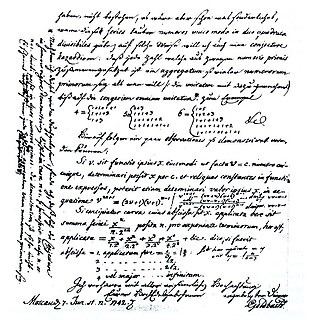 W
WIn the mathematical theory of minimal surfaces, the double bubble conjecture states that the shape that encloses and separates two given volumes and has the minimum possible surface area is a standard double bubble — three spherical surfaces meeting at angles of 2π/3 on a common circle. It is now a theorem, as a proof of it was published in 2002.
 W
WIn mathematics, the Dyson conjecture is a conjecture about the constant term of certain Laurent polynomials, proved by Wilson and Gunson. Andrews generalized it to the q-Dyson conjecture, proved by Zeilberger and Bressoud and sometimes called the Zeilberger–Bressoud theorem. Macdonald generalized it further to more general root systems with the Macdonald constant term conjecture, proved by Cherednik.
 W
WIn mathematics, the Ehrenpreis conjecture of Leon Ehrenpreis states that for any K greater than 1, any two closed Riemann surfaces of genus at least 2 have finite-degree covers which are K-quasiconformal: that is, the covers are arbitrarily close in the Teichmüller metric.
 W
WIn number theory, Fermat's Last Theorem states that no three positive integers a, b, and c satisfy the equation an + bn = cn for any integer value of n greater than 2. The cases n = 1 and n = 2 have been known since antiquity to have infinitely many solutions.
 W
WIn number theory, Goldbach's weak conjecture, also known as the odd Goldbach conjecture, the ternary Goldbach problem, or the 3-primes problem, states thatEvery odd number greater than 5 can be expressed as the sum of three primes.
 W
WIn group theory, Hajós's theorem states that if a finite abelian group is expressed as the Cartesian product of simplexes, that is, sets of the form {e,a,a2,...,as-1} where e is the identity element, then at least one of the factors is a subgroup. The theorem was proved by the Hungarian mathematician György Hajós in 1941 using group rings. Rédei later proved the statement when the factors are only required to contain the identity element and be of prime cardinality.
 W
WThe honeycomb conjecture states that a regular hexagonal grid or honeycomb is the best way to divide a surface into regions of equal area with the least total perimeter. The conjecture was proven in 1999 by mathematician Thomas C. Hales.
 W
WKefeng Liu, is a Chinese-American mathematician who is known for his contributions to geometric analysis, particularly the geometry, topology and analysis of moduli spaces of Riemann surfaces and Calabi-Yau manifolds. He is a professor of mathematics at University of California, Los Angeles, as well as the Executive Director of the Center of Mathematical Sciences at Zhejiang University. He is best-known for his collaboration with Bong Lian and Shing-Tung Yau in which they establish some enumerative geometry conjectures motivated by mirror symmetry.
 W
WIn arithmetic geometry, the Mordell conjecture is the conjecture made by Mordell (1922) that a curve of genus greater than 1 over the field Q of rational numbers has only finitely many rational points. In 1983 it was proved by Gerd Faltings, and is now known as Faltings's theorem. The conjecture was later generalized by replacing Q by any number field.
 W
WIn physics, the Painlevé conjecture is a theorem about singularities among the solutions to the n-body problem: there are noncollision singularities for n ≥ 4.
 W
WIn mathematics, Scheinerman's conjecture, now a theorem, states that every planar graph is the intersection graph of a set of line segments in the plane. This conjecture was formulated by E. R. Scheinerman in his Ph.D. thesis (1984), following earlier results that every planar graph could be represented as the intersection graph of a set of simple curves in the plane. It was proven by Jeremie Chalopin and Daniel Gonçalves (2009).
 W
WIn differential geometry, the Willmore conjecture is a lower bound on the Willmore energy of a torus. It is named after the English mathematician Tom Willmore, who conjectured it in 1965. A proof by Fernando Codá Marques and André Neves was announced in 2012 and published in 2014.